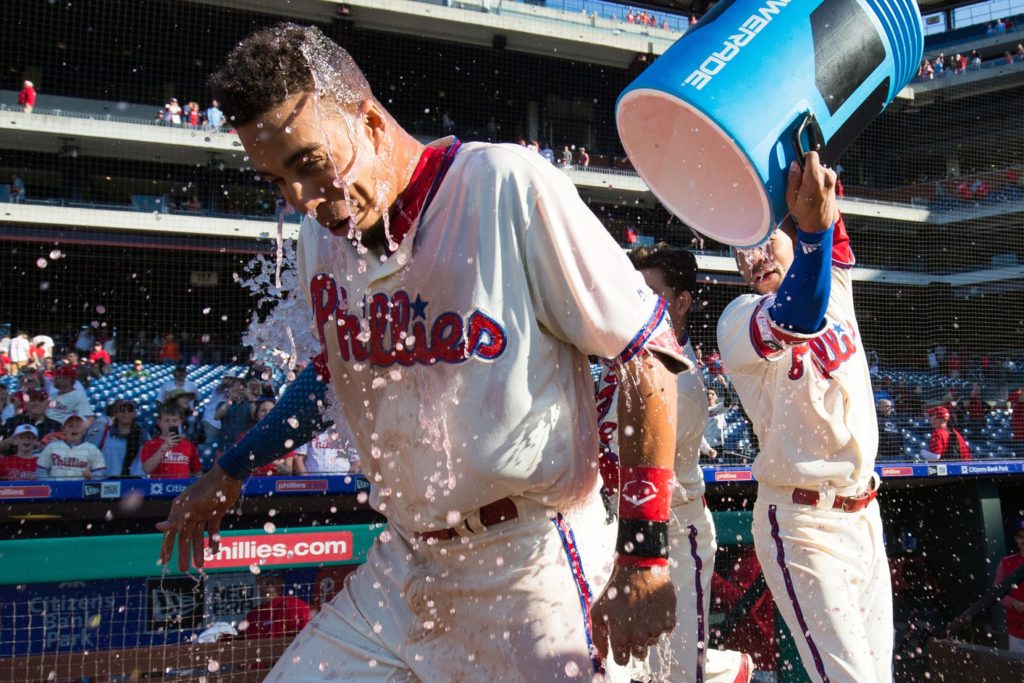Ad Disclosure
The Phillies Are Now a Problem in the NL East
By Bob Wankel
Published:

In addition to completing a four-game sweep over the previously red-hot Pittsburgh Pirates with their 3-2 walkoff win yesterday, the Phillies also accomplished something of great importance. They have seemingly established that Philadelphia summer baseball will be worth watching for reasons other than the nightly pyrotechnics show of sweat glistening from Gabe Kapler’s perfectly-sculpted physique. Those muscles, that tanned skin, ugh–they are going to pop. Swoon.
Anyway, the Phillies are 14-7 and have won 13 of 16 after a tumultuous start to the season. While their recent resurgence is undoubtedly welcomed good news, a look at recent franchise history over the last quarter century serves as a lesson that the team’s fast start is no guarantee of late season success.
The 2001 (20 games) and 1995 Phillies (19 games) both reached the 14-win mark faster than this current team and went on to miss the playoffs. In fact, the 1995 team started the season 24-10 and finished six-games under .500. On the other hand, the 1993 (18 games) and 2011 (20 games) Phillies got off to fast starts and never looked back.
While this oversimplified study is nothing more than a slight pump of the brakes to those planning for October baseball, there are legitimate reasons to believe this team is going to be in the hunt as the summer wears on, and the math appears kind.
There are 141 games remaining on the schedule. If the Phillies simply play one-game under .500 over the remainder of the season, which seems more than reasonable given what we have observed thus far, then that brings them to 84 wins. I also suspect, much the way I suspected the organization would use a historically slow-moving and tepid free agent market to their advantage as the offseason wore on, that the team will be a willing buyer this summer should their young core continue to prove its readiness over the next three months.
The pessimist will argue that there’s no way the Phillies’ rotation will continue to have the best ERA in the National League. While Aaron Nola and Jake Arrieta are proven commodities, Nick Pivetta (3.11 xFIP) or Vince Velasquez (3.18 xFIP) have exceeded expectations and Ben Lively has kept the team in games. I would concede some regression is likely, but in doing so, I would also submit that Carlos Santana (.151 BA), Nick Williams (.217 BA), and Aaron Altherr (.157 BA), are among a handful of Phillies that are ice-cold right now and will almost certainly rebound in the coming weeks. They will unlikely sustain their current .667 win-percentage, but this team is officially a problem in the National League.
As for the Gabe Kapler effect, I’ll say this: with roughly 13% of the season in the books, I still have no idea what to make of the guy. My current stance is that he is eccentric, hot, seemingly an egomaniac, but also possibly good at his job. The Phillies are 6-1 in one-run games, a perfect 4-0 in extra innings and have an astounding 10 come-from-behind wins. Those numbers simply cannot happen without what is, at the least, a competent manager. He’s going to roll the dice at times and make things weird and uncomfortable. Sometimes it’s going to work out, like it did yesterday when he had Nick Pivetta, who struck out in his first plate appearance, swing away instead of conventionally bunt in the fifth inning with the Phillies trailing 2-0:
https://twitter.com/BallparkVids/status/988131042472144896
That bold decision netted the Phillies two runs and directly led to a victory. And, regardless of what we think about him, he has seemed to weather the storm of a turbulent start. Watch them. The players are up on the rails of the dugout, bouncing around, and having fun.
Stuff like this doesn’t happen when a team doesn’t like its coaching staff:
The Phillies newest star, Rhys Hoskins, homered and then ran the ‘Philly Special’ play from Super Bowl 52 with his first base coach 💪🏼 pic.twitter.com/6EjFnxSkvy
— High & Outside Sports (@HighandOutside_) April 22, 2018
This roll the Phillies are on isn’t going to last forever. It may come to a screeching halt when the 15-6 Arizona Diamondbacks arrive tomorrow night, but at the very least, the Phillies are proving that meaningful baseball is back in town.
Bob Wankel covers the Phillies for Crossing Broad. He is also the Vice President of Sports Betting Content at SportRadar. On Twitter: @Bob_Wankel E-mail: b.wankel@sportradar.com